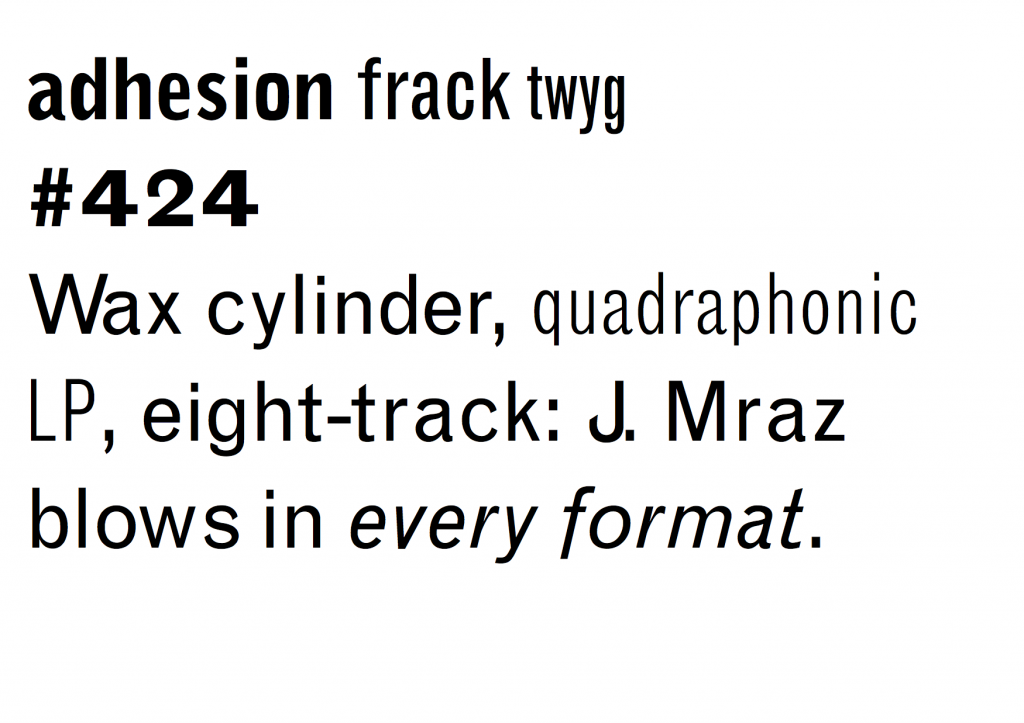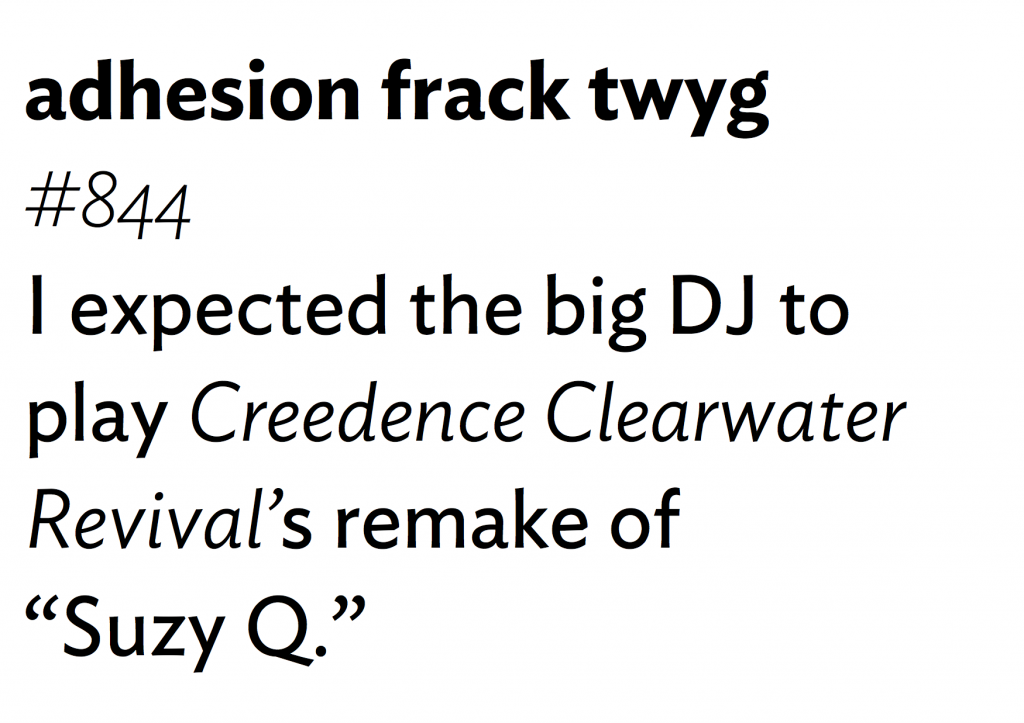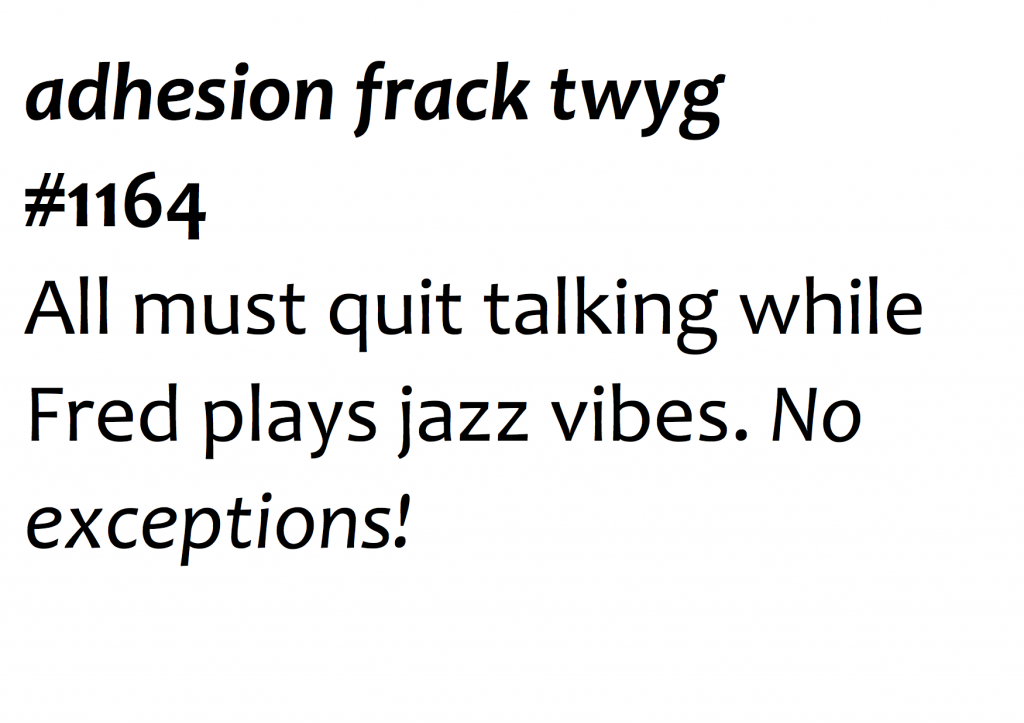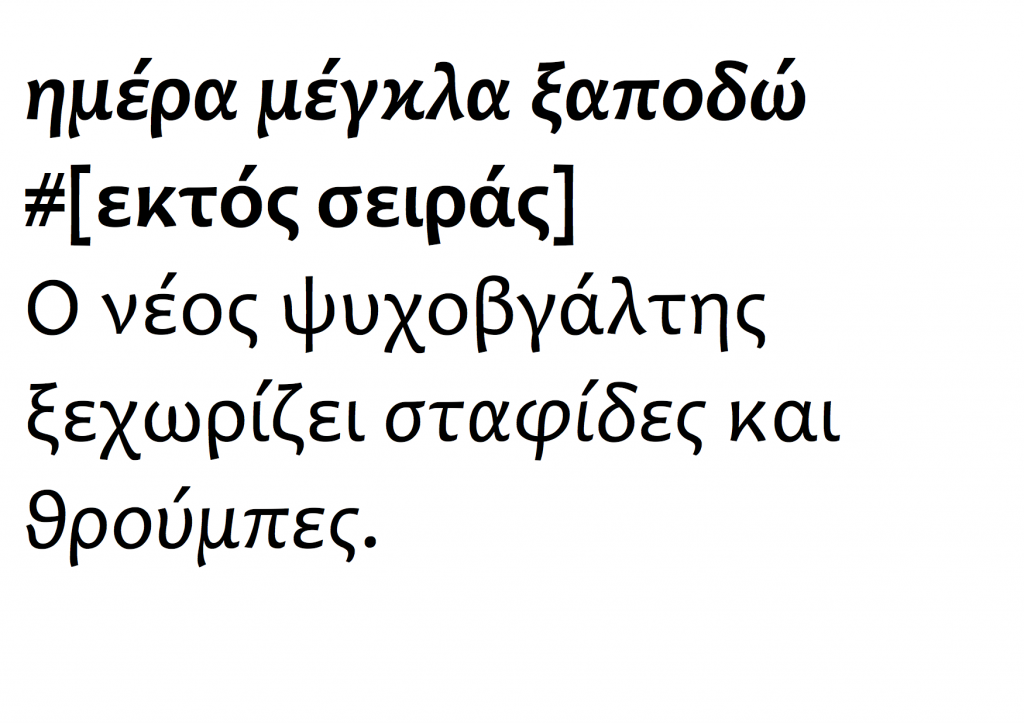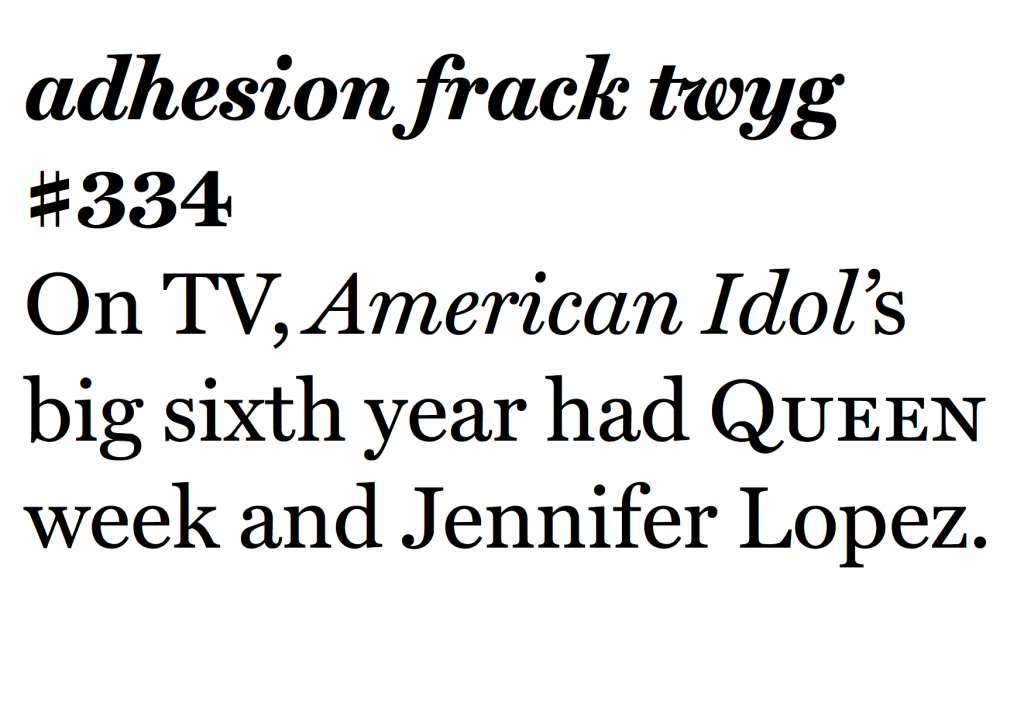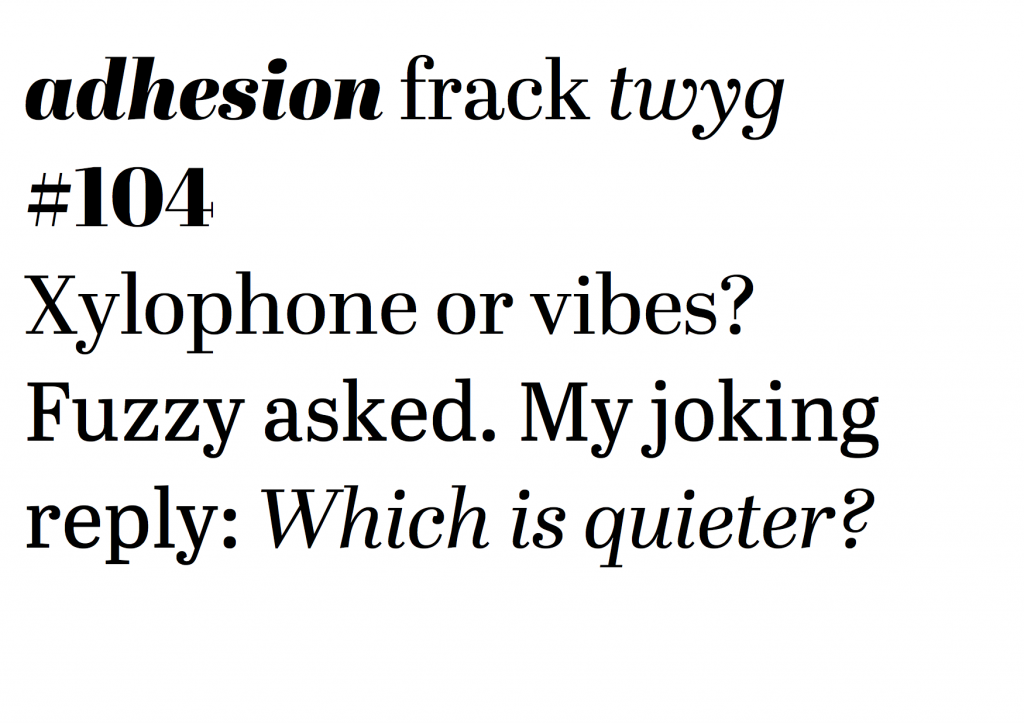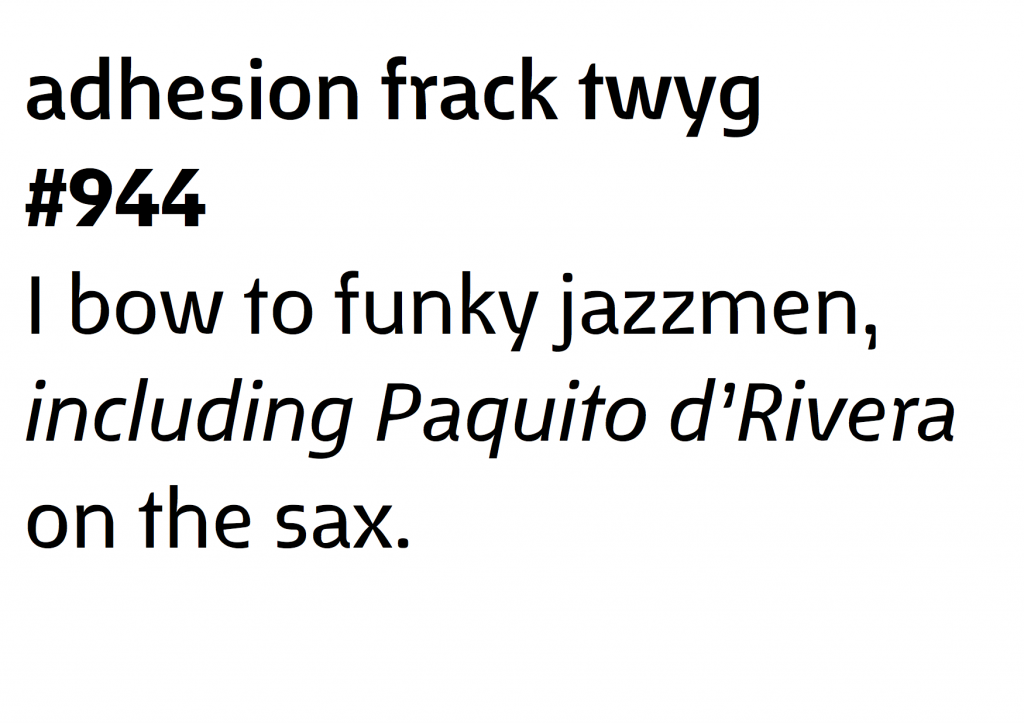 In the summer of 2013 Alexei Vanyashin asked for an interview for the (then still to-be-launched) online journal «Шрифт». The questions ended up being the most comprehensive set I had ever responded to. Over several weeks Eugene Yukechev (the editor) followed up with additional questions and clarifications, to make sure that my points were clear. It is rare to have the space to go deeper in an interview, and this one was a pleasure to do — for this reason, and for the professionalism of the editorial team. It is also a pleasure to see that Evgenia Basyrova‘s photographs captured the atmosphere in the Department.
In the summer of 2013 Alexei Vanyashin asked for an interview for the (then still to-be-launched) online journal «Шрифт». The questions ended up being the most comprehensive set I had ever responded to. Over several weeks Eugene Yukechev (the editor) followed up with additional questions and clarifications, to make sure that my points were clear. It is rare to have the space to go deeper in an interview, and this one was a pleasure to do — for this reason, and for the professionalism of the editorial team. It is also a pleasure to see that Evgenia Basyrova‘s photographs captured the atmosphere in the Department.
Below are my original responses in English, which formed the basis for the final text.
Журнал «Шрифт» Have there been any changes in the Reading MA Typeface Design programme over the last five years?
The programme changes every year. There are external factors (where we perceive the industry moving towards, and the direction in which we want to grow) and internal (the interests and personalities of the students, and the mix of the visiting staff).
Журнал «Шрифт» What are the highlights of the MA Typeface Design programme? What major skills and competencies are students expected to build?
The MATD is founded on the idea that typeface design exists at the junction of design practice, a historical and technological environment, and a cultural context. So, alongside designing typeforms, and specifying typefaces, our students dive deeply into historical, cultural, and technical research. Achieving a high level of practical skills comes with building a deeper understanding of how typefaces meet specific demands in a range of cultures. And, above all, is probably the change in the way of thinking about design, and your own practice. Graduates learn to think more critically about their discipline, and question the design decisions they make – not just for the typeface they work on while at Reading, but long after. Highlights would include regular workshops on scripts, seminar series from Michael Twyman and lectures from James Mosley, the annual field trip, as well as deeply personal moments of discovery and insight.
Журнал «Шрифт» The MA Typeface Design programme is known for developing multi-script typography skills — would you say this is market demand driven or an educational method?
Both, and then one more thing. Firstly, we are tracking the growth in demand for multi-script design skills in the type market. This is well recognised and indeed still growing from “mainstream” scripts (like Arabic and Devanagari) to scripts for smaller communities (like Khmer or Burmese). Secondly, we use designing for a wide range of scripts as a way to build better design skills: a deeper understanding of the relationship of written and typographic forms, and the developing conditions in global typography. And, thirdly, we use work in this area to develop research skills, the experience of working with archival resources and field work, and the construction of arguments.
We have developed a methodology that shows how the technological, corporate, and cultural environments in which typefaces are made have influenced the interpretation of the original, underlying scripts. Our method of typeface development takes into account the growth of non-Latin typeface design as an industrial enterprise in pre-digital and digital environments; the impact of type-making and typesetting technologies on the form of individual characters the typographic decisions in document design that reflect changes in type-making and typesetting environments; and the tension between tradition and modernity in contemporaneous visual communication. Once understood for the scripts each student is working on, this methodology can be applied to any script.
Журнал «Шрифт» At TypoBerlin 13 Erik Spiekermann expressed his disregards to Cyrillic. What is your take on Cyrillic? In regards to Latin and Greek, is it an alien script?
I do not know what context this was said in, so can’t guess what Erik meant, you’d have to ask him to clarify. My own interest in Cyrillic is from the point of view of a script shared by different cultures that seek to express a typographic identity, of communities of designers with very different backgrounds, and as an example of a script with a constantly developing typographic repertoire.
From a design point of view, I think that the three european scripts are a superb lesson in developing consistent typographic identities from very different fundamentals. In the Cyrillic, you have a degree of intentional form-making, and a combination of elements that require a deep understanding of the script structure, with a very specific history of adaptation to historical models. In the Latin you have a very high degree of formal uniformity and a grammar that allows the widest range of configurations, but a fairly narrow scope for innovation. This, in my view, makes it possible to achieve moderately successful (and slightly boring) designs easily, but makes innovation more difficult. Greek is at the other end of the scale, like an unconnected-Arabic: it has eastern scribal roots, a single writing style at its roots, and is based around counters and loops, rather than strokes. Put all three together, and you’ve got a superb lesson in typeface design.
Журнал «Шрифт» Is it often for students to express their willingness to design a Cyrillic? How do you find the overall level of Cyrillic in the MA projects?
I would say that there is only a moderate desire to cover Cyrillic. If I had to speculate why, I’d say that the relatively healthy production of typefaces from Russia and Serbia, and increasingly Bulgaria (possibly other places, too) makes Cyrillic less of a challenge in research terms. As for the work of MATD graduates in Cyrillic, I do not think I have the expertise to voice my opinion. When a student wants to cover Cyrillic I am primarily interested in how they propose to build the right skills themselves: you want a student to have a solid research-based approach, and to build a methodology that will allow them to build skills for any script.
Журнал «Шрифт» The Reading programme, as opposed to t]m, includes a large analytical research. What are its benefits?
In this Reading is not only different to the KABK, but to any course that is situated in an art school. All the courses in the Typography Department at Reading are informed by us being part of a research-intensive university (and, indeed, a very highly-rated one). Typefaces do not exist in a vacuum: they take form and meaning because they are responses to many other typefaces that exist already, and to changing conditions of use. Good research skills, and a sufficient understanding of typographic history and practice, are essential.
For example, how can a Russian designer create a good typeface for the Latin script, or Greek, or indeed anything else – and vice versa? Surely just being able to read the language is not enough, otherwise any graphic designer who can move a Bezier curve would be a good typeface designer. Apart from the skill of working with details that combine to create a typographic texture, a typeface designer can engage with what’s appropriate for a document type, and for specific uses: this is all pretty basic stuff, but it is based on research. And innovation requires a deeper understanding of what it is you are innovating against: what is the common position that you are re-thinking?
Журнал «Шрифт» Do you consult students on their Cyrillic? What is the hardest part in consulting on Cyrillic?
We try to support the scripts the students do, with regular feedback by relevant experts. Cyrillic has been one of the most difficult to find good support for, partly because of the very small number of suitable experts who are resident in the UK, or permitted to work here. The way we teach requires repeated contact, which is even more difficult. Unfortunately the costs and visa situation looks like it will get worse before it gets better.
Журнал «Шрифт» What are your preferences in typographic conferences and events?
I have a soft spot for ATypI, and enjoy hugely TypeCon. I also try to attend as many of the one-day and evening events at St Bride as I can (my favourite location for type gatherings in the UK). There is an increasing number of UK events that make it very difficult (and expensive) to keep up: TypoCircle, TypoLondon etc., Point, events in Birmingham, and many more. I am also very happy when I can attend smaller events like TypeTalks, where there is an opportunity to meet many people. In recent years I have been talking at events that are not targeted at typographers and typeface designers (like the tightly-focused Ampersand) that require me to think more deeply what is relevant from typeface design to other fields. My second-favourite events outside the UK are in Poland, which I find buzzing with activity. And my top-of-the-list is the triennial ICTVC, first in Thessaloniki, and recently in Cyprus, which brings together a very unique mix of specialists.
Журнал «Шрифт» What are the key discussion topics in the typographic world today?
There are three areas we are discussing intensely. Firstly, the globalisation of typography and typeface design. This means not only that wide script coverage, but also that designers think about wide type families, and typefaces that allow typographic differentiation in scripts that have not had a developed tradition for this. For example, starting with a script that until recently only had a low-modulation stroke, to develop a modulated display style will require a decision about the angle of stress and how it changes along the forms. There are many different possible implementations for this, and the structure of the letters does not give obvious answers. Conversely, removing the contrast from a heavily modulated style may distort the letterform in unacceptable ways. These are hugely exciting areas, of intense innovation.
Secondly, some areas of typography are changing rapidly, mostly due to the rethinking of what “document” mean in a world of smaller, user-responsive devices. In this environment the typefaces and the typography at the paragraph level become a key identity identifier.
Thirdly, we are seeing typography and typeface design maturing into a recognised discipline, with its own established literature, numerous education pathways, and a growing understanding of its importance by the wider public.
These three areas make working in typeface design and typography today more exciting than ever.
Журнал «Шрифт» What is your take on the phenomena of the ever-growing Monotype Foundry?
I think this discussion is a distraction. The current Monotype company will never have a hold on the document-making industry like the two main companies did in hot-metal years. The type business is growing rapidly (witness the rapid growth of small- and medium companies, like Type-Together, HFJ, and DaltonMaag). There are, however, two very interesting aspects in Monotype’s activity: one is their rediscovery of the importance of their historical know-how, and the other is their move into the area of online documents, with Typecast – the most exciting new company, from my perspective.
Журнал «Шрифт» What is the most important skill, a student must learn on the MA course?
To ask questions! To think critically about the forms they make, and the typographic world around them.
Журнал «Шрифт» Maxim Zhukov considers you the best type design educator in the world today. What do you think is the key ingredient of this success? What should a successful teacher be?
Yikes! This is an embarrassingly generous compliment, Maxim is very kind. I think a good teacher tries to give the student what they need, and also push them a little bit outside their comfort zone, while being sensitive that each person needs different challenges. I try to do this, but I am sure there are graduates who hate my guts.
Журнал «Шрифт» How would you describe the role of Gerard Unger on the course, how many hours does he spent with students?
Gerard is as central to the MATD as Fiona and myself are. He visits six times a year, for four days each time. He covers a wide range of topics, and is instrumental in shaking things up. He does not let students be satisfied with something just good enough, and keeps pushing them. He also exceptionally patient and insightful when students are looking for inspiration. Gerard also contributes with many lectures, and looks after half of our field trip. I think that we have a very good balance of influence, and complement each other well. And we are good friends.
Журнал «Шрифт» Are there any new guest lecturers on the course? Who was visited Reading with a lecture recently? What topics are are of interest to the students?
Many visitors contribute each year, in addition to Michael Twyman’s twenty seminars, James Mosley’s similar number of lectures, and Victor Gaultney’s six all-day visits. This year we’ve had people doing workshops (e.g. Wayne Hart for two days on stonecutting, and Martin Andrews on letterpress); visiting speakers like Richard Grasby, John Hudson, Paul Barnes, and Myra Thiessen; and people running multi-day sessions, like Tom Grace, David Březina, and Miguel Sousa. We also have speakers for all our MA programmes in common, like David Pearson and Lawrence Penney; and about a dozen PhD researchers presenting their work.
Журнал «Шрифт» What makes a successful student project?
The student projects are primarily learning tools: the best projects help the students become great typeface designers, able to do exceptional typefaces after they leave Reading, and be great collaborators. If the typefaces get published and have a commercial life of their own, then that’s a bonus.
There also students who do not go into type design; for them the projects are learning experiences of a different kind, and there you need to focus the project on what would benefit the student more. We’ve have people who come to Reading with, say, ten years of software engineering experience, or twenty years of book design experience. In such cases the objectives are tailored to what would give those students a steep learning curve, a good challenge that is relevant for their career.
And, in all cases, you want the graduates to leave with a love for typography and typeface design, and with an open mind for themselves and their discipline.
Журнал «Шрифт» On your recent TypoBerlin talk you mentioned that there is an increasing number of Reading students from Germany. Is Germany in your opinion more typographically active than other countries? Or could you say the interest in typography is decreasing in the UK?
We have always had strong interest in the course from Germany, and it does seem to have increased in recent years. Germany is a unique market in Europe: it is not only mature typographically, but also large enough to sustain its internal typographic education and publishing industry with no need to translate native texts, or seek to sell in other countries. At TypoBerlin I was teasing the audience a bit, so I will rephrase my question as: “in a saturated market, how can a young designer distinguish themselves?” This is, to a growing degree, a challenge for new designers in many other countries.
As for the UK, I do not think interest is decreasing at all; on the contrary, it is growing; we see this at Bachelors, Masters, and PhD levels. But the UK market is different: it is very international in exporting skills and services, as well as in receiving talented professionals form other countries. In the creative industries, London is by far the most international city in Europe: although cities like Berlin attract a lot of self-employed designers (mostly due to the lower cost of living) it is London that has the business turnover.
Журнал «Шрифт» The technological aspect of the production of type design over the last ten years has greatly improved(evolved). Nowadays a good type designer is often a good programmer. How did this affect teaching type design, how has the practical methodology changed?
The expectations from type designers on the technical level have increased in recent years, but gradually, and not fundamentally: there’s more to learn, and some stuff may seem more complex, but nothing is prohibitive for entry in the profession: you don’t need a degree in computing. This means that a motivated graphic designer can easily pick up the training to shift to type design. This is similar to designers having to learn to work in proprietary markup languages, SGML, XML, and so on: nothing new. The intensity of the comments on this is more revealing of the short memories of the commentators, rather than any deeper shift. Type foundries are full of technically very competent people who learned through online resources, and short workshops. So, I think this is something of a non-issue: designers have always had to learn about the technology of their field, and it never was at university-level.
The real challenge, where there has been a fundamental change in type design, involve the expansion in skills into non-Latin scripts. The level of knowledge required there to produce competent designs is not within the realm of the self-educated. The research and interpretation skills that a new designer would need to tackle unfamiliar scripts are simply not possible to develop on your own. And, unfortunately, for many scripts we do not have yet widely available resources to support this. This area is leading the elevation of typeface design from a craft-based activity to a profession with a recognised body of knowledge and skills. We are still at the very beginning of this process, but in another ten years this will seem too obvious to mention.
Журнал «Шрифт» What are the career options of today’s Reading graduates?
Many are employed in type foundries (like DaltonMaag, Fontsmith, or Hoefler & Co). A good number work for Monotype, Adobe, and Microsoft. Quite a few work as individual freelancers, publishing through other foundries. And it is important to mention Type-Together and Rosetta Type, two foundries founded by graduates with considerable growth. About a third have some engagement with teaching – either full-time or part-time, and this is growing as graduates want to add variety to their careers. As type design schools grow in number, this will continue to rise. And about a third return to graphic design work while doing a bit of type design.
Журнал «Шрифт» Why do you think Russian type design students prefer Holland to England for their education? Is it merely a question of finances?
You’d have to ask them, but my impression is that the financial difference is overwhelming for a Russian applicant. And because there is no framework for student loans or suitable scholarships, students rely on personal or family finances. This is just crazy, and discriminates heavily against people with talent.
Журнал «Шрифт» If you were to explain to a prospective student, how would you underline the main differences between Reading and KABK MA programmes?
You asked me a similar question already. Why compare with the KABK, and not Porto, or Elisava, or FADU-UBA, or Gestalt? In the recent exhibition of student work at the Ampersand conference there were well over thirty institutions represented. So, your question is misleading, as if there are only two places to study type design. Regardless: I advise applicants to visit the schools they consider: it is important to meet their tutors, ask questions about studying there, and get a feel for the place. Speaking with graduates is also important.
Now, specifically about the difference between Reading and the KABK: we are not an art school, but a university programme, in a department with a range of related programmes, and forty years of institutional experience of PhD and staff research in typography. Our student read and discuss at a high level, and conduct research in type design that is often ground-breaking. They work on typefaces that get them design jobs, and produce academic works that get them teaching jobs, and help other designers as well. When they graduate, they publish proper type specimens and dissertations that have weight and content, not ephemeral posters. These are our strengths. Worldwide, the trend in type design education is to emulate what we do.
Журнал «Шрифт» The inability to design non-latin fonts by non-native readers has been discussed at conferences. It turns out Reading MA programme counters this, providing an opportunity for designers to be involved in the multilingual typographic scene. Is that true?
This is, unsurprisingly, nothing new: this challenge is central to the history of typeface design, and grew rapidly in the second half of the 20th century. At Reading we have records of such discussions from the 1960s at least, as well as documents that show how people addressed the design problems of unfamiliar scripts. With Fiona Ross we have developed a methodology that builds on these earlier processes, and is based on a combination of research and script-specific practice. We start with the manual foundations of a script, with sensitivity to tools and substrates, and an analysis of writing practices. We correlate this with research into the type-making and typesetting technologies that influenced the typographic implementation of the script (for example, hot-metal technology imposed limitations in the character sets, the forms of individual letters, and the way forms combine, that do not apply to today; to reproduce these restrictions would be not only ignorant, but plain bad design). We then explore the way in which typeface design reflects the tension between tradition and modernity in visual communication, which is a key consideration in typeface design (for example, the associations with monoline strokes as “modern” or “traditional” are entirely relative to precedent and regional associations, not inherent in the shape itself). Finally, we investigate typeface design for complex typography within each script / language combination, by analysing past and current publications from that community. These considerations allow for a more nuanced development and testing environment, that allows talented designers to cover scripts they are unfamiliar with. While there is always a requirement for testing with native readers, this is much more towards the end of the development process than people tend to think.
Журнал «Шрифт» In your opinion, does it make practical sense to design Cyrillic without a having Greek extension? (Does designing Greek aid in working with Cyrillic?)
In the case that a project is driven by a client’s brief, the Greek many or many not be part of what the client is paying for, at least initially. Certainly for a pan-European market the Cyrillic may come first, but experience shows that big branding projects tend to “script creep”: the initial briefs get extended as the brand spreads to more regions. So, the designer may well add Greek after the Cyrillic is delivered. Another answer depends on the designer’s plans for building a library: there is a competitive advantage to script coverage, and — once you’ve got a Cyrillic or a Latin — the Greek is relatively easy to do compared to other non-Latins. Finally, there is the point I made elsewhere: designing Greek and Cyrillic for the same project is a good design challenge.
Журнал «Шрифт» Could you give us a list of ‘Gerry Leonidas recommends’ books that no type designer/typographer can live without?
This is a difficult question to answer without some limits on time, or some idea of the experience of the reader. There are fourteen key topics we discuss on the MATD, and I select texts for each depending on the ideas we want to discuss. In that sense, a book or article that is controversial might be more useful in the environment of a structured, guided discussion. But the same text might be misleading if someone reads it on their own without pointers. (I am slowly putting the lists for these seminars online.)
I also never include books like Robert Bringhurst’s Elements of typographic style, or Philip Meggs’ History of graphic design: titles like these are on every designer’s bookshelves, and to include them would repeat the obvious. And I don’t include some targeted titles (like Cyrus Highsmith’s very good Inside paragraphs, because I prefer to discuss spacing alongside Tracy and Dowding’s methods, as well as objects: a page of Didot and a screen of Instapaper with Nicole Dotin’s Elena selected.)
So, which texts? I’ve got a list for incoming MA students on the new Typeface Design site which I think is a pretty good starting point. It also includes some comments on magazines and blogs that form an essential part of a typographic designer’s horizon. I occasionally update the listing, but prefer to have items that have proven their value, rather than the latest title.
